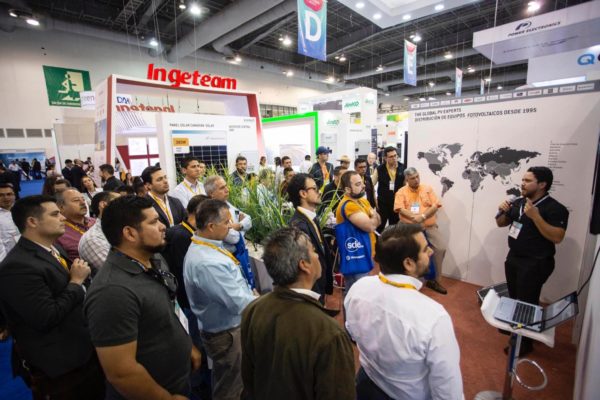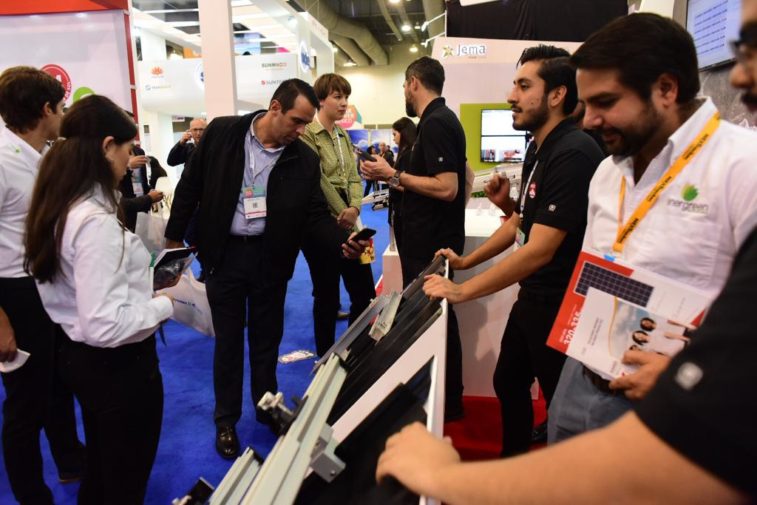All the major Asian module manufacturers, as well as the biggest European and Chinese inverter makers, participated in the event last week at Centro Citibanamex in Mexico City. Prospects and fundamentals of the Mexican PV market remain solid, with the distributed-generation segment in particular set to drive future growth. The large-scale PV segment, meanwhile, will continue to develop through bilateral PPAs.
Solar Power Mexico has already earned its place among solar exhibitions throughout the world. The event was a showcase for a PV market that continues to thrive in the face of regulatory uncertainty. Although the Mexican regulatory framework remains sufficiently favorable and the government of Andrés Manuel López Obrador (AMLO) has yet to demonstrate open hostility toward renewables, some feared that the administration’s initial statements on clean energy development could cast a pall over the exhibition from the start. But this did not happen.
Although the Mexican regulatory framework remains sufficiently favorable and the government of Andrés Manuel López Obrador (AMLO) has yet to demonstrate open hostility toward renewables, some feared that the administration’s initial statements on clean energy development could cast a pall over the exhibition from the start. But this did not happen.
“The impact of political uncertainty was limited,” Eduardo López — project director of Solar Power Mexico and Industrial Transformation Mexico — told pv magazine. “Growth is so strong that it will be difficult not to pay attention to renewables… people can truly reduce the cost of their electricity bills through photovoltaics and stopping that is going to be very difficult. We believe that the market will continue to grow.”
Key figures
Deutsche Messe of Germany, SNEC PV Power Expo of China and the Solar Power International (SPI) of the U.S. — the three organizers of the fair — said in a post-event release that there were 78 exhibitors, of which 40 were non-Mexican companies. “Of the international exhibitors, 24 came from China, eight from the U.S. and three from Spain, with other companies from Israel, Austria, Canada, Guatemala and Brazil,” they revealed. The number of industry professionals who attended the fair surpassed 5,000 people, in a venue spanning 5,540 square meters.
The number of industry professionals who attended the fair surpassed 5,000 people, in a venue spanning 5,540 square meters.
According to López, some exhibitors have already started asking about booking booths for next year. “(One of) our American partners told us that they made more contacts on the first day of the fair than at other renewable events here in Mexico,” he added. “That is more than expected, definitely.”
López attributed the high number of Chinese companies at the event to his Chinese partner’s direct contacts in the country. “But there were also many Mexican companies there. Excel Solar, a well-known distributor of PV products, bought one of the largest stands at the fair,” López added.
The organizers expect to attract more smaller companies in 2019. “We expect to grow by 20% in terms of the number of visitors, with even more conferences and workshops,” López said. “This year we were a bit conservative, as we didn’t believe that so many people would participate. We want to more exhibitors that produce storage technologies, since this will play a very important role in the Mexican market in the coming years.”
Exhibitors and visitors
With the sole exception of Longi Solar, all of the world’s major PV module suppliers were present. Chinese manufacturers such as Jinko Solar, Trina Solar, GCL and JA Solar showed up, along with Talesun, Suntech, Jolywood, Canadian Solar, HT Saae, Astronergy and Znshine Solar. Germany’s AE Solar and South Korea’s Hanwha Q Cells were also on hand, as was U.S.-based SunPower, which produces panels in Mexico at two different factories, with more than 1 GW of production capacity.
The largest inverter makers at the show included Switzerland’s ABB and Israel’s Solaredge, as well as Spanish companies such as Jema, Ingeteam and Power Electronics. China-based Growatt and Sungrow, as well as German companies such as Fronius and Siemens, were also on hand.
“It was a pleasant surprise, as it was much more crowded than expected, although the situation was not particularly favorable due to the cancellation of the auction,” Alberto Cuter, general manager of Latin America for Jinko Solar, told pv magazine. “Undoubtedly, the professional level of the solar industry in Mexico has grown a lot and Mexican companies in the market are increasingly competent for both project development and EPC construction, as well as installers and, obviously, product distributors.”
Cuter said that many C&I projects are now being developed through private PPAs in Mexico, which will be the trend in the coming years. “Jinko Solar presented several products here, particularly the new Cheetah bifacial module with 158 cells, which we believe will be the best-selling product in the coming years,” he concluded.
Álvaro García-Maltrás, general director for Latin America and the Caribbean for Trina Solar, agreed about the future of bifacial panels in Mexico. “We think that from 2020, most of the new large-scale PV projects will use bifacial modules in Mexico,” he told pv magazine. “We have placed a strong bet on this fair, of which we are a platinum sponsor, and we have been very satisfied with the level and quality of the attendees.”
Armando Negrete, an executive at ABB Mexico, also declared the event a success. He said the group would definitely attend Solar Power Mexico 2020. “We had a lot of very important people at our stand, but the most important thing was the quality of the people who were there,” he said. “All our inverter solutions have had very good acceptance and customers have reacted very positively.”
Ricardo Morales of Fronius Mexico agreed, pointing to the high degree of specialization at the fair. “The people who are coming know what they want. They ask very specific questions. There are also people who want to learn, but there is a large number of specialized people and that surprised us a lot,” he said.
But it was not just global companies that praised the event. Many domestic players were also pleased.
“There is a considerable growth in the residential, commercial and industrial segments,” said Luís Gonzales, commercial director of Mexican distributor Exel Solar. “People are very excited and many are getting into this business now. It has been quite interesting — the amount of people, as well as the quality and highly professional profile of the people who came to our stand.”
Another surprise was the presence of Brazilian integrator Sices Solar, which specializes in distributed-generation projects. “We are very excited about the Mexican market,” said Lucas Troia, company director. “We will come next year and with a bigger stand. We want to replicate our Brazilian model here to educate customers about quality, not just about prices. We are coming with new partners and we are confident that we can succeed in this market.”
Mexican prospects
In short, Solar Power Mexico has shown that the fundamentals of the country’s solar market are still strong, despite lingering policy uncertainty. Despite the cancellation of the fourth long-term auction and the government’s decision not to hold any new auctions at least for the next few years, the future is not that grim, given the number of bilateral PPAs announced in recent months. However, distributed generation is the segment that could take the lead in the coming months and years.
The most pleasant surprise of the fair was discovering that storage projects could be bankable in Mexico within two or three years, according to the president of the Association of Solar Mexican Energy (Asolmex), Hector Oléa.
“Depending on the region and the type of project, storage will represent a concrete option for renewables in this country very soon,” Oléa said.
Although other observers believe such projects won’t be feasible for another three to five years, there is no doubt that storage will play an enormous role in the Mexican electricity system in the coming decades, given the country’s lack of transmission capacity.
“We expect prices of storage systems to be reduced by half in the next two or three years,” Oléa said.
This content is protected by copyright and may not be reused. If you want to cooperate with us and would like to reuse some of our content, please contact: editors@pv-magazine.com.









Great project and I hope you people continue to improve the capacity and durability of the panels, I installed them in my house in Queretaro,would like to know if there is a battery to keep the energy stored on it in the house